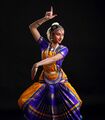Bharatanatyam
Bharatanatyam
Bharatanatyam is one of the oldest and most prominent classical dance forms of India, originating in Tamil Nadu. Traditionally performed by women in temples as a form of devotion, it has evolved into a widely recognized performance art with deep roots in Indian culture, spirituality, and aesthetics.
Etymology
The name "Bharatanatyam" is often interpreted as a combination of:
- Bha – Bhava (expression)
- Ra – Raga (melody)
- Ta – Tala (rhythm)
- Natyam – Sanskrit for dance
History
Bharatanatyam traces its origins to the Natya Shastra, an ancient treatise on performing arts by sage Bharata (circa 200 BCE). Originally a temple dance performed by devadasis (female temple dancers), it was a form of religious expression and storytelling.
During British colonial rule, Bharatanatyam declined due to moral and cultural suppression. In the 20th century, artists like Rukmini Devi Arundale and E. Krishna Iyer revived it as a respectable and widely taught art form.
Costume and Makeup
- Costume: A specially stitched silk saree, often in bright colors, that allows freedom of movement.
- Makeup: Bold eyes, red-colored fingertips and feet, and traditional temple jewelry to emphasize expressions and movements.
Components of a Bharatanatyam Performance
- Alarippu – An invocatory piece to warm up the dancer
- Jatiswaram – A pure dance sequence showcasing rhythm and grace
- Varnam – The central and most elaborate item combining both nritta (pure dance) and abhinaya (expression)
- Padams – Expressive pieces interpreting lyrics and emotions
- Tillana – A rhythmic and lively conclusion
- Shloka or Mangalam – A concluding benediction
Music and Instruments
Bharatanatyam is performed to Carnatic music. Common accompanying instruments include:
- Mridangam (percussion)
- Nattuvangam (cymbals)
- Violin
- Veena
- Flute
Themes and Symbolism
Themes usually revolve around Hindu mythology, especially stories of:
- Lord Shiva (as Nataraja – the Lord of Dance)
- Lord Krishna
- Goddess Parvati and other divine figures
The dance expresses deep emotional states and devotional themes through symbolic hand gestures (mudras), facial expressions, and rhythmic footwork.
Modern Bharatanatyam
Today, Bharatanatyam is a global art form, performed in classical and contemporary styles. While traditional schools (gurukulas) continue to preserve its classical form, modern choreographers explore new themes and global collaborations.
Notable Practitioners
- Rukmini Devi Arundale
- Yamini Krishnamurthy
- Padma Subrahmanyam
- Alarmel Valli
- Malavika Sarukkai
Gallery
-
Traditional Bharatanatyam pose
-
Bharatanatyam costume and jewelry
-
Nataraja - The cosmic dancer


